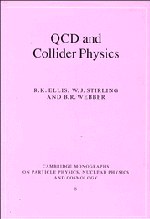Book contents
- Frontmatter
- Contents
- Preface
- 1 Fundamentals of QCD
- 2 Asymptotic freedom and confinement
- 3 QCD in electron-positron annihilation
- 4 Deep inelastic scattering
- 5 Parton branching and jet simulation
- 6 Jet properties beyond fixed order
- 7 Hadroproduction of jets and photons
- 8 Electroweak interactions
- 9 The production of vector bosons
- 10 Heavy quarks
- 11 Higgs bosons at high-energy colliders
- 12 Measurements of the strong coupling constant
- Index
3 - QCD in electron-positron annihilation
Published online by Cambridge University Press: 05 May 2010
- Frontmatter
- Contents
- Preface
- 1 Fundamentals of QCD
- 2 Asymptotic freedom and confinement
- 3 QCD in electron-positron annihilation
- 4 Deep inelastic scattering
- 5 Parton branching and jet simulation
- 6 Jet properties beyond fixed order
- 7 Hadroproduction of jets and photons
- 8 Electroweak interactions
- 9 The production of vector bosons
- 10 Heavy quarks
- 11 Higgs bosons at high-energy colliders
- 12 Measurements of the strong coupling constant
- Index
Summary
Many of the basic ideas and properties of perturbative QCD can be illustrated by considering the production of hadrons in electron-positron annihilation. In this chapter we will discuss a variety of ways in which the theory can be tested. We begin by discussing the total cross section for e+e → hadrons: we show how the order αs2 corrections are calculated, and how renormalization scheme dependence enters at order. Because of its inclusive nature, this is one of the few quantities for which the first three terms in the QCD perturbation series are known, and for which non-perturbative corrections are expected to be small. As a result it provides potentially one of the most precise measurements of the strong coupling.
Perturbative QCD also predicts a rich ‘jet’ structure for the final-state hadrons in electron-positron annihilation. We discuss the various ways in which jet cross sections can be defined, how such cross sections are calculated in perturbation theory, and how the predictions compare with experiment. Jet cross sections can also be used to measure αs, and to test the basic interactions in the theory, in particular the triple-gluon vertex.
The total hadronic cross section
The production of a muon pair in electron-positron annihilation, e+e− → μ+μ−, is one of the fundamental processes of QED. The same annihilation process can also produce hadrons in the final state. As we have seen in the previous chapter, the formation of these hadrons is not governed by perturbation theory. Why then would one expect a perturbative approach to give an accurate description of the hadronic cross section? The answer can be understood by visualizing the event in space-time.
- Type
- Chapter
- Information
- QCD and Collider Physics , pp. 53 - 85Publisher: Cambridge University PressPrint publication year: 1996



